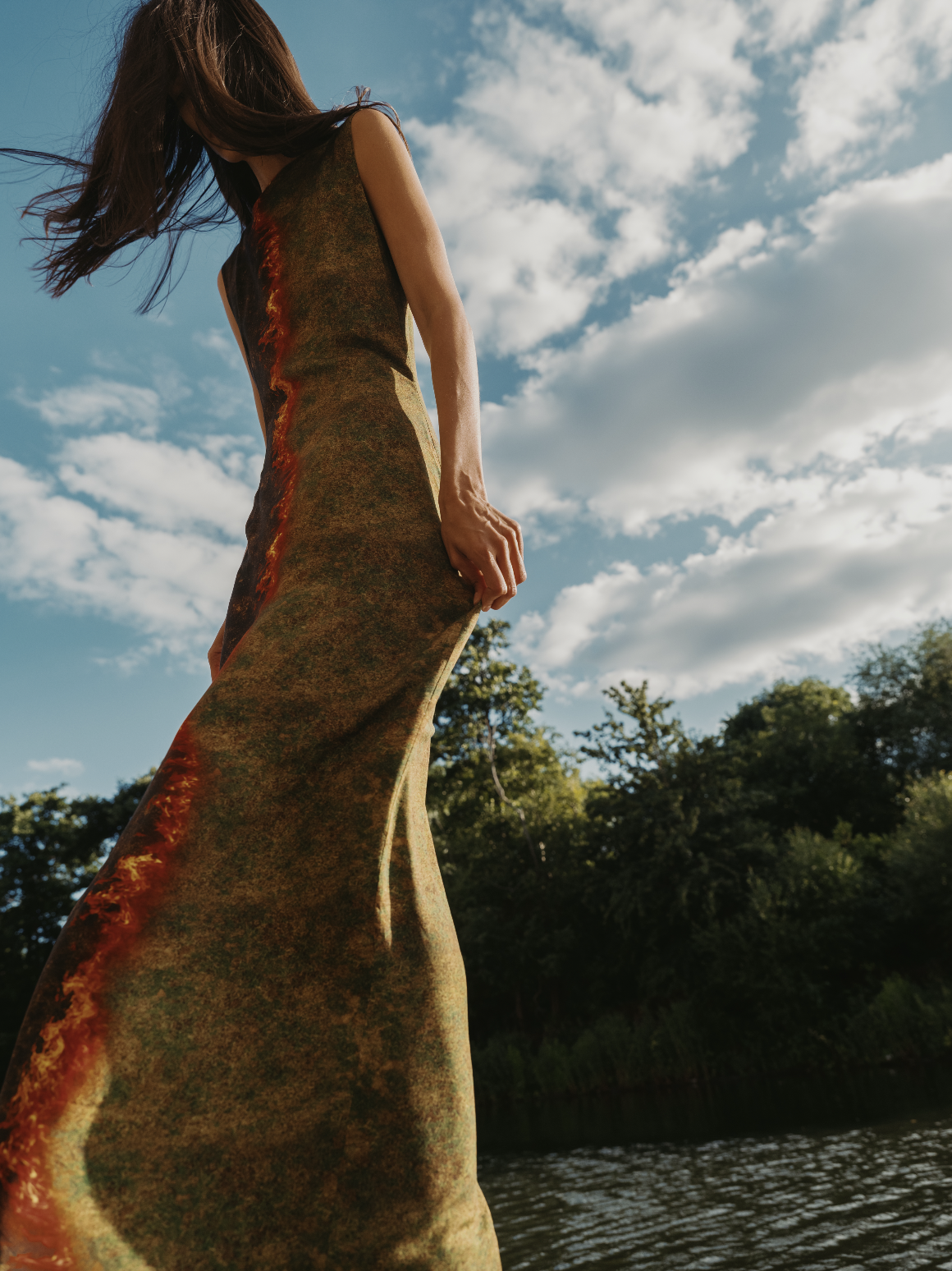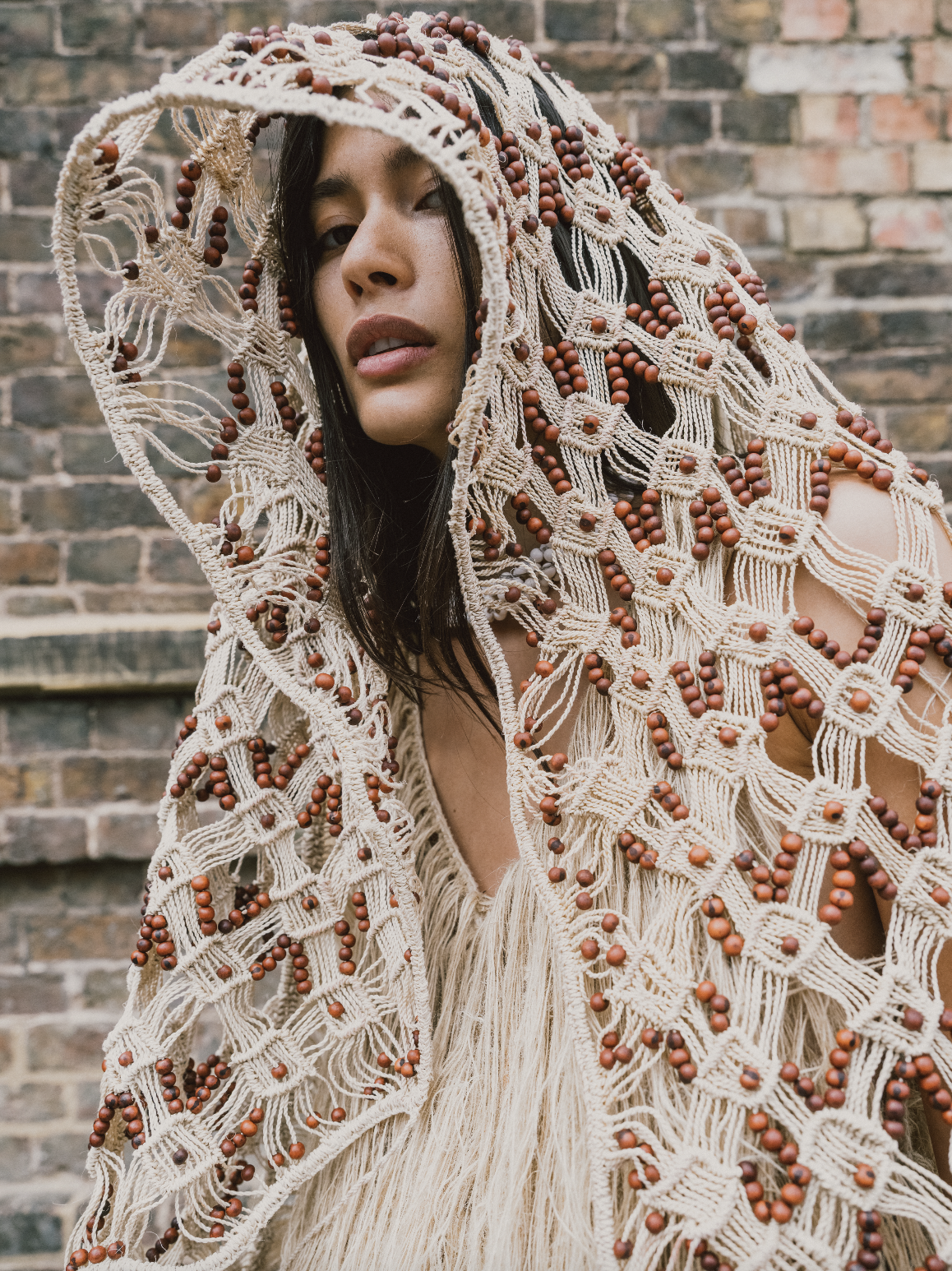‘Brazil: Creating Fashion for Tomorrow’ shines a light on socio-environmental values, innovative practices, and designers to watch
Lilian Pacce, one of the creative minds behind the London-based project, sat down with Mola to share recent accomplishments and what the future holds.
Photography Gleeson Paulino
Dress by Nalimo. © BCFT
“I believe that fashion can have a more positive impact on the world, as opposed to what we see every day. Fashion can be less polluting, more inclusive and regenerative. It has such a huge potential to mobilise people,” says renowned Brazilian fashion journalist, author and curator Lilian Pacce, when asked about her motivations to make ‘Brazil: Creating Fashion for Tomorrow’ happen.
Along with Pacce, sustainable fashion specialist Camila Villas and fashion designer and creative director Marilia Biasi are collectively responsible for the project, which started in 2023 as a commission initiated with input from the Embassy of Brazil in London. Biasi, the first of the trio to speak to the Embassy, told Pacce about the delegation’s interest in making Brazilian fashion an important part of the local conversation, and therefore giving more visibility to its responsible practices, materials, and creators.
The first edition of BCFT, launched two years ago during London Fashion Week, was more of a trial version, an event that worked as both an exhibition and a panel talk. “We opted to showcase Brazilian brands and designers that were based in the UK and Europe, but that used more sustainable materials,” Pacce explains. Joao Maraschin, the first Brazilian designer to be shortlisted for the LVMH Prize in that same year, was one of them. Maraschin’s artisan designs are known for the use of recycled and upcycled dead stock. Other UK-based labels founded by Brazilians and celebrated for their upcycling techniques and inclusive mindset, such as Karoline Vitto and Renata Brenha, were also part of BCFT’s debut.
“We compiled this list of designers and worked on showcasing sustainable materials that were being used, for example, Pirarucu’s fish skin, microbial biopigments that can be applied in textile dyeing and cosmetics, and experiments from the Royal College of London, where they utilised bacteria to develop different fabrics,” Pacce adds.
Dress by Normando. © BCFT
Digitally printed in EcoVero viscose.
Sisterhood mindset
Due to a very positive response from the public and the Embassy, the BCFT went from a one-off idea to a yearly event that shows no signs of stopping anytime soon. The 2024 edition, once again in partnership with London Fashion Week, was called ‘A Chain of Women’ and, as the name suggests, was focused on exhibiting the work of female creatives in fashion.
Data from the International Labour Organisation (ILO), published in March 2023, showed that nearly 60% of garment workers worldwide are women, with this percentage rising to 80% in certain regions, like Brazil. For that reason, Pacce explains, last year’s BCFT spotlighted brands that were not only female-led but also supported other women within the whole supply chain.
“We showcased the designers and creative directors, as well as the women who make the clothes behind the scenes. Especially in Brazil, most of these women are probably responsible for providing for their families through their work in fashion, which is not often spoken about. It’s made invisible, despite being so important,” she adds.
With over 1,000 visitors, last year’s edition kept its key values of sustainable practices and artisanal work, exhibiting examples of fuxico (internationally known as Suffolk Puffs and fabric yo-yos), lace, and macramé techniques. Designers Catarina Mina, Flavia Aranha, PatBo, and Lenny Niemeyer were some of the highlights.
From the Amazon, with love
Although BCFT’s previous editions took place during London Fashion Week, in September, this year’s event happened last June, in partnership with London Climate Action Week. Titled ‘(re)weaving Amazonia’ and held at Coal Drops Yard, in King’s Cross, it explored the work of creatives and professionals from the Brazilian Amazon region, involving Indigenous peoples, diasporic communities and designers leading sustainable innovation. Not by chance, the 30th annual United Nations Climate Change Conference (COP30) is set to take place in the Amazonian city of Belém next November, and the BCFT team has been in talks with the organisation to bring the project to Brazil.
This was potentially the most difficult edition to put together so far, due to its shorter timeframe and more complex theme, Lilian Pacce explains. “I have a long relationship with the Amazon region, so talking about it was a dream come true. It’s such a rich part of the world in terms of biodiversity, materials, creativity and this ancestral knowledge, which is very diverse. When we talk about the Indigenous peoples, we tend to put them all in the same category, but they are not the same. There are specific cultures, styles, and traditions, and we had to be super careful to put this all into the exhibition without sounding patronising.”
Also supporting this year’s event, both financially and through content production, the organisations Amazon Concertation and Arapyaú Institute brought key players to BCFT to promote relevant discussions about climate-related issues. Panel talks were held simultaneously with the exhibition, with Indigenous activist and communicator Samela Sateré Mawé as one of its highlights. The exhibition is very aspirational, voices Pacce.“An exhibition is a great way to engage with people, they come in to learn something that they know nothing about, and leave the space with more information.” But the conversations, for her, are equally important. “We can try and discuss solutions for some of the issues, but also bring consciousness and visibility to these topics, whether they are problems or positive things,” she explains.
The showcase, with a portfolio of labels that grows exponentially every year, featured established Brazilian brands such as Alexandre Herchcovitch, Lino Villaventura, FarmRio and Cris Barros, as well as more recently known names including Dendezeiro, Normando, Nannacay and Misci.
As Pacce explained, part of the goals of ‘Brazil: Creating Fashion for Tomorrow’ involves exploring the three different pillars of fashion, sustainability, and innovation. Besides that, she adds, it’s crucial to also decentralise Brazilian fashion from the broadly known cities of Rio de Janeiro and São Paulo. Although they represent local hubs for the industry, she recognises, there is a myriad of relevant designers, brands and artists from outside those areas.
Dress by Nalimo, Shawl by Arévola Caruá.
Shawl crafted from curauá fibres sourced from the Waimiri Atroari Indigenous community. © BCFT
A – transformative – drop in the ocean
For Lilian Pacce, the fact that the project is gaining momentum and support over the years is outstanding, although she hopes for more. For BCFT to keep its relevant status on a global level, it’s fundamental, for example, that more than the Brazilian creative community based in the UK remains part of it. “It’s not easy for us to earn respect and this space internationally. There’s still a strong stereotype, and people don’t know a lot about our fashion; they don’t access it,” she affirms.
“But this year we were supported by Headland, The Nature Conservancy, and King’s Cross. When you realise that those people are seeing what you do and understanding its value, it means a lot. We want to show that London is a cosmopolitan city and talk to multiple people, to showcase the positive and creative sides of Brazil, where we can work with regenerative practices, more sustainable and responsible materials. We want to offer an alternative to the world, and we don’t want people to see us from this extractivist mindset,” Pacce says.
Brazil is undeniably on the radar of foreign brands, which, once in a while, see the country as a source of visual inspiration. For Pacce, however, this interest seems to come in waves. “In the 80s, people were interested in the Brazilian beachwear brands, the Brazilian bikini, which made the item very popular. At the end of the 90s and beginning of the 2000s, because of Gisele [Bündchen], people started talking about Brazilian fashion again. But it’s not something that continues as an ascending curve, it’s still a wave. It would be great to see some sort of stability,” she says.
More than just an exciting scenario for international brands, Pacce aims for Brazil to be valued globally for its great potential. “Brazil inspires a lot, and we can see that from how international labels explore our country. However, they don’t really do any partnerships with local brands to maybe showcase our product better, and I think we should have more of that. Nothing undercover or hidden, but collaborative. That’s why this project gathers everything I believe in,” she concludes.









